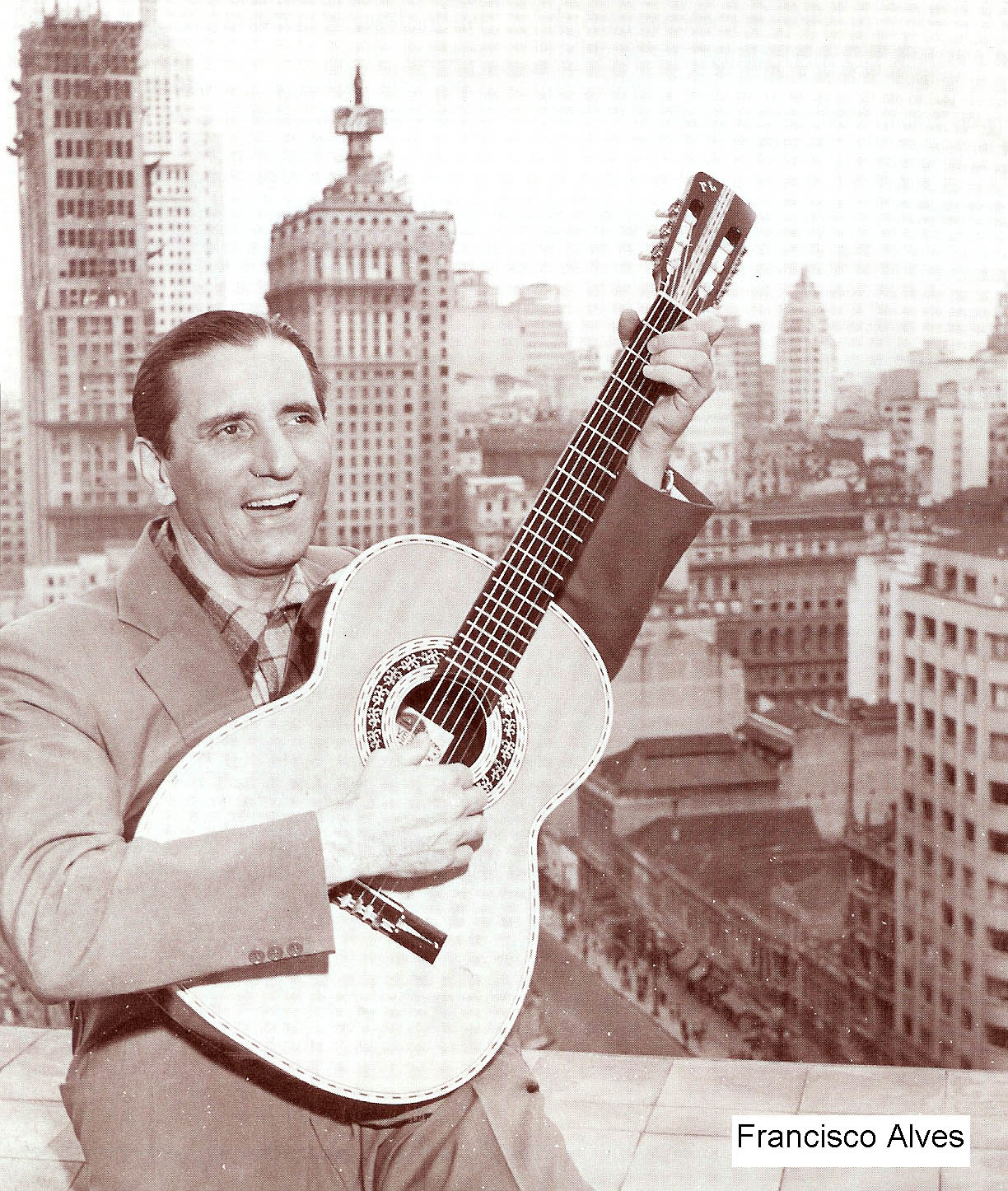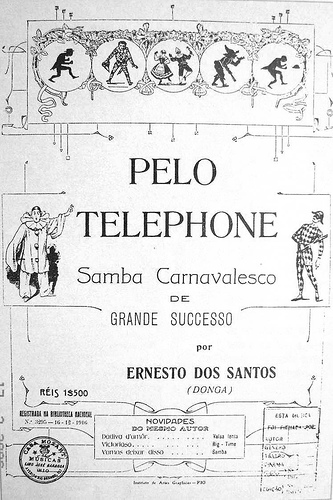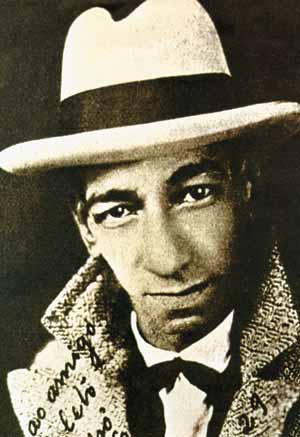Bryan McCann, a professor of History at Georgetown University, is a prominent scholar of Latin American History. His work focuses in particular on the
intersection between music, popular culture, and politics. His book, "Hello, Hello Brazil: Music and The Making of Modern Brazil" explores the development of Brazilian popular music between the 1920's and 50's. He sat down with Afropop producer Marlon Bishop for this interview.
Marlon Bishop: To start – give us the big picture. What were prevailing ideas about “Brazilian-ness,” and how did that change over the course of the time period you researched in your book?
Bryan McCann: I think the biggest change was really the change in the understanding of race and its meaning in Brazil. If we go back to the 19th century when Brazil is a slave society, the understanding of nationhood in 19th century Brazil was a romantic nationhood based on a myth of a combination of Portuguese and indigenous influences. A myth because, frankly, that had never happened to any large extent in Brazil where the indigenous population had mostly died as a result of European disease and had been pushed out.

The Afro-Brazilian population, was very much discriminated against to the degree that it was not thought about as a component of the nation. That began to change in the late 19th century.
Marlon: How did music play a role in that?
Bryan: The music of Rio de Janeiro in the early 20th century is Afro-Atlantic music. Right from the beginning, there's an understanding in Brazil that Afro-Brazilians are crucial to the way this music emerges and the way this music is played. As that music starts to get more popular and as the depth of that popularity is revealed by the enthusiasm with which consumers start to buy these records of an emerging record industry, it really poses a challenge for Brazilians to start thinking about the meaning of popular culture and its relationship to national identity. Now they have to think about, "We live in a society where our most popular music is Afro-Brazilian music. What does that tell us about our country?"
Marlon: Tell us about that music. What is samba, and where did it come from?
Bryan: There are a lot of different answers for that and probably most of them are right in one way or another. [laughs] I look at it from a different perspective and say that even by the late 1930s, samba does not really exist as a coherent genre. Instead, it's being formed in radio stations and recording studios, as well as other places.
One of those other places was favelas. If you ask most Brazilians, they'll say, yes, samba comes from the favelas in Rio. The favelas are the laboratory for the definition of the rhythm. There are various different ways of phrasing it because it is a flexible rhythm but, at the same time, it has defining characteristics. Those are expressed in their consolidated format for the first time in a favela in the neighborhood of Estacio in downtown Rio, and that becomes known as the Estacio sound. That really sets the pattern of samba as it will grow and expand over the 1930s.
Marlon: I want to step back a little bit. What are the precursors to samba?
Bryan: In the 1910s, there were a lot of people playing maxixe, which is rhythm that comes straight out of this Afro-Atlantic matrix. For the most part, that's instrumental music but there are some of the maxixes with lyrics.
And there are various other popular genres that are floating around Rio in that context, where they're being played in private parties for the most part in the neighborhood of Praça Onze, The most famous residents there are the Baianas, these older, black women who come from the state of Bahia. But there is also just a very broadly mixed working, lower/middle class population there, mixed in terms of national origin, in terms of race, in terms of occupation. And there are wild parties there, rent parties, every weekend that become a forum for this musical innovation.
Marlon: There are rent parties in the 1970s' lofts sense of paying their rent with the party?
Bryan: Exactly, it's the Baianas who are hosting the party and people make a small contribution and that's what, basically, allows them to keep going, to pay their expenses. Those are contexts that are seen as kind of risqué by elite society but, because of that, they're attractive at the same time, so they're not suppressed. There's a myth of the suppression of these and, occasionally, repression will happen but more frequently there's this kind of ambivalent attraction. Actually, these parties thrive throughout the 1910s, so a kind of spirit of musical innovation comes out of this.
Marlon: Who were some of the characters who were playing around the Praça onze scene?
Bryan: There are so many great musicians on this scene, and few of them actually become associated with this genre of samba. The one who is the first to register a samba that becomes known as the first samba was named Donga. He registers the composition "Pelo Telofone" down at the National Library as a samba. It was required that you would give the rhythm of the composition that you were registering, so he registered it as a samba, although rhythmically it's not yet in the rhythm that will become the dominate samba rhythm in the late 1920s.
Donga kind of grasps the changing nature of popular entertainment and the recording industry. He realizes it's important to now take these things downtown and get them registered, and that's the way you're going to get credit and get rights and, ultimately, royalties. So, "Pelo Telefone" is it Donga's anymore than it's anybody else's? I think these things came out of a kind of collective ambiance of innovation, and somebody else could have taken that downtown and registered it, and it would have been just as legitimate, but he's the one who happened to do it. [laughs] And it was very clever of him to do it. He was very clearly a great musician, as well.
He was not as great a musician by any stretch as his colleague, Pixinguinha, who's one of the towering, titanic figures in Brazilian music in any period who was also very active in that scene, but he's much more known as a choro composer than as a samba composer.
I would say that it's crucial that, in that period, those two scenes are very much overlapping. What Pixinguinha said himself later is that, "Oh, yeah, at those parties of the Bahianas, we played choro in the living room and samba out on the back patio," something like that.
Marlon: That’s a famous phrase in choro circles.
Bryan McCann: Totally. Everything that Pixinguinha did informed the way samba was later recorded and the way samba was later played in radio stations. So, Pixinguinha was fundamental in establishing patterns in the way samba would be played, but he's not generally thought of as a samba musician.
And then there's Sinhô, who becomes probably the first commercially successful samba composer and performer in the 1920s. The rhythm that he's playing in is still pretty much maxixe. It's not yet what we would consider to be mature samba of the late '20s and 1930s, but he writes very catchy. So, he becomes the king of samba in the 1920s.
Marlon: So how did that “mature samba” of the 1930s come about?
Bryan McCann: Estacio is itself a mixed neighborhood, which is directly adjacent to Cidade Nova. One of the odd things about Estacio in that period is that it contains a favela, the mojo de San Carlos, which is a large favela. So Estacio you have a kind of bleeding of the favela and the urban neigborhood. So in that favela, there's a particularly innovate group of young musicians who start experimenting with these new percussion instruments that they're pretty much developing themselves, although it's coming out of an Afro-Atlantic tradition, of course. They start playing with the rhythm, as well, and coming up with a more syncopated rhythm but one that's very catchy and can be easily learned, easily repeated and easily matched to different contexts.
They also start composing short, catchy refrains. Basically, that becomes a coherent sound for them in the late 1920s. They kind of open up what had been the maxixe rhythm and the maxixe form. And, lyrically, they make it simpler, structurally they make it simpler, rhythmically they make it more complex, and this has the collective effect of kind of breathing new air into samba. If you listen to an Estacio samba of the early 1930s compared to a Sinhô samba of the early 1920s, you can hear the transition pretty clearly. The Estacio samba just seems to have more buoyancy to it.
Marlon: Your book talks a lot about the radio and media culture. Tell us a little bit about that landscape, and why it was important?
Bryan McCann: Radio before the 1930s in Rio is pretty minimal. There are a few stations, but they have very small audiences because most people did not have radios yet. As in most places, the first radio station was very self-consciously designed for the elite. Also, it tried to have a program of social uplift and education, so musically it programmed classical music exclusively, which, in some ways, kind of kept the audience small.
Nonetheless, radios themselves were a hot consumer item, so people were saving up money, buying radios. Radio was one of the first items that is purchased on a layaway plan in Brazil, so people will make monthly payments to purchase these radios and get them over the course of a year or so. So, as the population of radio owners starts to spread, the population of radio listeners starts to demand different material being played by the radio stations. And, not surprisingly, they're interested in hearing popular music, not opera. So, they start making demands that radio programmers inevitably start to respond to by programming popular music.
Marlon: How does samba get onto the radio at first?
Bryan McCann: There are variety shows on the radio in Rio that have, as the name suggests, a wide variety of programming: musical, theatrical and short skits. They start inviting the most popular musicians in town, including some of these young samba musicians.
Now, I argue that those samba composers, once they're in this environment of the radio station and the recording studio, also begin to change samba in definitive ways, in ways that are going to play a crucial role in making it popular beyond a few neighborhoods in Rio and making it popular throughout the city of Rio, and then very quickly thereafter throughout the nation of Brazil. It's the samba composers in that context, in the recording studios and in the radio stations, that start changing the subject matter of samba, that start getting interested explicitly in this relationship between samba and what it means to be Brazilian.
Marlon: What was Radio Nacional, and how did it play a part in this?
Bryan: Radio Nacional is a radio station in Rio that was not very popular in its first three years of existence. It was started as a private radio station in 1936, and then it's taken over by the federal government by the dictator Getúlio Vargas, who's in power from 1930 to 1945.
Because they were owned by the federal government, they essentially had no overhead. They didn't have to worry about paying rent, they didn't have to worry necessarily about paying for a new radio tower. Those kinds of expenses would be taken care of. It meant that they could operate as a commercial radio station but plow all of their profits back into programming. So, it meant that they could hire the most famous musicians in Brazil, the most famous entertainers in Brazil, the most famous and most skilled writers in Brazil. Radio Nacional just became a power house of popular entertainment in 1939 and then throughout the 1940s, 1950s into the 1960s.
Marlon: What about it’s famed auditorium?
Bryan: Radio was a glamorous, popular industry and the idea of producing radio as live entertainment was part of a star system. It was something that fans went crazy about.
Very few radio programmers were putting on records- almost all radio entertainment was produced live in the studio. And Radio Nacional was one of the first stations to make that production itself part of the entertainment spectacle. So, it created a big auditorium where fans would come and watch radio being made. For the musical programs, this meant watching a big orchestra play or watching a small group play instruments on stage and, above all, watching the popular singers, who had tremendously charismatic popular presence. That's what would bring in the fans. So, yeah, people would line up for hours to get tickets to watch these most popular radio shows.
Marlon: Eventually, Radio Nacional broadcasts throughout Brazil. How responsible is this radio station for the kind of creation of a Brazilian culture out of these incredibly disparate regions? Was everybody all of sudden listening to samba and thinking of that as their music, even if they were far from Rio where this music came from?
Bryan: I don't think Radio Nacional alone was decisive in creating a more or less coherent national popular culture in Brazil. I think it's just the flagship of a popular entertainment industry that's rooted in Rio. So, even before Radio Nacional itself becomes the most popular station in 1939-1940, samba has already taken root decisively at the local level, and is pretty popular nationally as popular entertainment based on the national cinema industry itself, which had already produced some very popular films in the early 1930s.
Radio Nacional then just kind of accelerated that process. I think Radio Nacional is not so decisive in establishing a national popular culture, but it is crucial in the form, in the sound of samba as it's played in the 1940s and 1950s.
Marlon: So, who was Getúlio Vargas, and what did he want to do with national culture in Brazil?
Bryan: Getúlio Vargas rose to power in Brazil in 1930, and then, to everyone's surprise – perhaps including his own – he held onto power until 1945. Then he stepped down and returned five years later in 1950 as elected president. Then, finally, shot himself in office in 1954.
So, really, he had a 25-year period of ascendancy over Brazilian politics. At least 15 of that as a dictator where we has able to play an enormous role in establishing patterns for Brazilian economic and political development. Inevitably, given the other transitions that Brazil is going through of urbanization and industrialization, that would be a process of cultural transformation, as well.
So, the transition in the understanding of Afro-Brazilian presence in Brazil that goes from being seen as a detriment to being seen as an advantage, that's already well underway before Getúlio Vargas comes to power. And that's certainly not something that comes out of his initiative, but it's something that his administration very much supports by the mid to late 1930s and that Radio Nacional certainly helps to truly make national in late 1939 and then throughout the 1940s.
Marlon: When does the so-called “myth of racial democracy” get established in Brazil?
Bryan: In the 1930s, people didn’t use the phrase “racial democracy,” Instead, what's becoming prominent in the 1930s and becoming increasingly widely accepted is this idea that Brazil is culturally strong in large part because of its Afro-Brazilian inheritance, and that cultural strength is what's going to make Brazil distinctive among modern nations and is going to help to make it a competitor of modern nations in other ways: politically, economically, etc.
Now, as we've come to recognize, that understanding of the importance of Afro-Brazilian inheritance co-exists with persistent racism in Brazil. Nothing about this transition does away with the reality of racism in Brazil, but it does very profoundly change the way Brazilians think about Afro-Brazilian culture. And it does allow for much greater opportunities for Afro-Brazilian musicians, for example, and it does make possible, or it plays a part in, this acceptance of Afro-Brazilian culture as the national culture.
Marlon: To what degree is samba, and by extension Afro-Brazilian culture, being kind of used by the state to try and create this sense of togetherness?
Bryan: Of course, Getúlio Vargas, as a populist dictator, grasped onto popular culture, so he would have radio stars visit him in the national palace and have their picture taken with him. He became very well known among popular musicians and radio personalities in Rio as a friend and a supporter.
Even before becoming president, when he was still just a congressman, Vargas had already advocated for laws that would favor the radio industry in Brazil. So, he was already seen as a kind of ally of popular entertainers before he became president. But there was a strong alliance between Getúlio Vargas and the most popular radio entertainers in Brazil.
So, yeah, I would say Getúlio Vargas is trying to use samba, the most popular entertainment in Brazil as a kind of gloss on his administration.
Marlon: You were talking about how the generation of sambistas that came out of the Estacio changed the lyrical content of samba – tell us about that?
Bryan McCann: I think the key figure in transforming the lyrical content of samba is Noel Rosa, who is a white samba composer. He's from the lower middle class. 
He was in med school, but he was a terrible student. He was really interested only in the bohemian life in downtown Rio, in playing music.
He's in, many ways, a tragic figure. His jaw was crushed at birth, so he was disfigured. As a result of that, he always had tremendous insecurity, didn't like to be seen in the daylight and was always very uncomfortable about meeting with new people and eating in public. But at night, he would be free to become himself out in the cabarets and the dive bars of Rio. That's where he lived his fullest existence, becoming this tremendously creative samba composer.
So, he's very much in tune with Estacio samba, but he's also in tune with these processes of industrialization, of urbanization, of formation of a working class and in new understandings of Brazil. He's bringing all of that into his lyrics at the same time. One of his early sambas, for example, "Tres Apitos," "Three Whistles" is about a clearly autobiographical character who's driving around this factory trying to catch the attention of a young girl who is a factory worker. It's a song that just captures factory labor in Rio in the early 1930s and the entire system of class relations that goes along with that. And it's expressed perfectly in the Estacio samba rhythm. It's very beautiful.
Marlon: In your book, you write a little bit about this pattern of poor Afro-Brazilian composers writing hits for lighter-skinned radio stars. Can you tell me a little bit about how that worked?
Bryan McCann: There's an interest in Afro-Brazilian culture as being one of the engines of Brazilian cultural vitality, but there's certainly nothing like equal-opportunity for black, Brazilian entertainers. They have greater opportunity in the 1930s than they had earlier, partly because the industry itself is growing, but they have nothing like the possibilities of stardom of what performers.
It's not really until the 1950s that you're going to see black singers reach level of popular stardom in Brazil. So, in the 1930s, what you have much more prominently are black instrumental players who become crucial in the recording studios and radio stations, and then black composers who are not getting chances to sing on the radio. Instead, they sell their songs to white performers.
So, the most famous example are the collaborations between Ismael Silva of Estacio and Francisco Alves, who is the most famous radio singer in the 1930s, who is white and has a very glamorous presence. He's actually from a working class background, but he very successfully obscures that by constantly riding around in a limousine and is wearing very well tailored suits and trying to appear like a cosmopolitan gentleman, whereas Ismeal Silva is from the favela, and he's got no real possibility of becoming a radio star in the 1930s.

Ismeal Silva sells sambas to Francisco Alves, and both parties seem to understand that that transaction is what's necessary to making these hit sambas and making them part of the music industry.
Marlon: Let’s talk about the “malandro.” What did that word mean?
Bryan: The roots of the word “malandro” are “bad man.” The idea is the malandro is a bad guy, but malandro, what it comes to mean in 1920s Rio is a kind of tough guy, but a debonair tough guy, who wears a scarf around his neck and who wears well-shined shoes and has a kind of high-stepping, swinging way of walking through the streets of downtown Rio and has an ability or willingness to take on all comers, but to do it in a very stylish way.
Malandros’ defining characteristic, in addition to these aspects of style, are that they disdain work because they don't want to take on work that they're not going to be well paid for. Manual labor is the only thing that they have an opportunity to take on, coming from the working poor in Rio, so that's not going to pay well and they're not going to do that kind of heavy work for poor pay.
Instead, what they do is gamble, or the reputation is they get involved in petty crime or some kind of illegal activity. The idea of malandro is one that's very criticized. When anyone looks like a malandro in practice, it's very much an idealized type, but anyone who seems to fall into this category is very discriminated against, is seen as just a kind of layabout and a parasite on the economy. But they're also associated with samba because this is what they do: They hang out in bars or on street corners, shaking a matchbox in a samba rhythm, singing sambas and inventing sambas.

(A later depiction of the Malandro)
In the 1930s you start to get more complex songs that are linking this idea of the malandro to an idea of national identity and seeing Brazil, itself, in some ways as a malandro.
Marlon: In a prideful way?
Bryan: Exactly, turning this into an aspect of national pride, rather than derision or discrimination. Being a malandro starts to be seen as being a good thing because it means being clever, being crafty and stylish all at the same time. So, then what we see in the 1940s is a new collection of sambas about malandros that are starting to look at this understanding of the connection between malandro and what it means to be Brazilian in different ways, and in ways that are always shadowed by race because the stereotypical malandro is black.
So, Wilson Batista, for example, has a beautiful song about a malandro, "Chico Brito," from the early 1940s, which just kind of captures the really clever way that Wilson Batista and a number of other black Brazilian composers came at issues of race and class in the 1940s in very subtle, tricky ways.
The character of Chico Brito is a malandro, a classic malandro who avoids work, who smokes marijuana, who gets involved in various dubious enterprises and who is arrested yet again by the local police. The samba goes on to talk about how Chico Brito, when he was young, was a good boy, he was very good in school and to suggest that the reason he turned into malandro is because he didn't have any opportunities.
Then the final quatrain of the samba asks this question of, "Well, if man is born good and he turns bad, is it his fault? Or is it society's fault?" which, on the one hand, is a very clichéd and stereotypical question, although perhaps not so much in the favelas of Rio in the 1940s.
What's funny about it is that, in the samba, this comes out of the voice of Chico Brito, so you don't know if this is the malandro asking the question in a very malandro way, in a very clever and tricky way that’s going to kind of prey on the guilty conscious of the listener, or if this is the composer saying, "Has he been turned into malandro because society is corrupt and discriminatory?"
Marlon: So you don’t know if it’s a con or a critique?
Bryan: Yes, it's both of those things at the same time, which is part of what makes it really fantastic. Because there really was not an opportunity for explicit annunciation of racism in Brazil in the 1940s because that rhetoric of racial flexibility had become so powerful and the rhetoric and the idea of Afro-Brazilian culture as being crucial to Brazil had become so powerful, it was very difficult to then say, "No, Brazil is still racist." You don't see that until the 1960s.

Marlon: Let’s change gears – tell me about Ary Barroso and the samba-exaltação?
Bryan McCann: Ary Barroso is a composer who often said of himself that he was not a sambista because he's not from the favela. When he says he's not a sambista, though, he doesn't mean that in a derisive way; he believes that sambistas have a kind of rhythmic gift that he doesn't necessarily have, that his gift is elsewhere. So, even in Ary Barroso self definition, you sense some of this ambivalence about what it means to be a sambista or what it means to be a composer who happens to compose samba.
As a composer, he's best known, first of all, for "Aquarela do Brasil," which is the unofficial national anthem of Brazil and is certainly better known than the official national anthem. And it's got the very powerful voice of Francisco Alves. Above all, it has unforgettable lyrics and melody. The melody is very glorious, very dramatic, perhaps melodramatic. The lyrics are about how great Brazil is. What they're saying is that Brazil is great because it's malandro in a kind of idealized way.
So this is the prototype and the ultimate example of samba-exaltação, exaltation samba, which is samba about how great Brazil is. It becomes maybe the most prominent samba of the first half of the 1940s, although it co-exists with these very tricky sambas about race and the malandro that are not at all exaltations of how great it is to be a Brazilian. So, you have both of these trends within samba at the same moment. It suggests that one is the kind of soaring, major-key theme, samba-exaltação, and the other is the kind of minor key, brooding, second-movement or counterpoint to that.
Marlon: Carnival for so many people is kind of the defining thing of samba and today it's almost like that's where samba lives. How does samba become the defining of Rio Carnival and how does that affect samba?
Bryan: Already by the late 1920s, people are playing samba at Carnival and you have these blocos, which are informal parade bands. They don't really rehearse, or if they do, they rehearse maybe just once or twice and then they take to the streets and they start playing a song. The Estacio composers start to change that by creating a samba school. They say that they're going to be more formal than just a bloco. They are going to actually rehearse and they're going to write their own sambas, practice them and play them in a much more coherent way. That's very successful at both generating new hit sambas, and then also drawing a crowd that's going to follow them through the streets.
So, it's their first samba school that becomes really pivotal now in creating a new forum for samba at Carnival, and rival samba schools start up very quickly and imitate this model.
Then, in the early 1930s, you have a popular sports newspaper that, during Carnival season, has nothing to report on. So, the only way that this sports newspaper can keep selling copies is by reporting on Carnival. And the best way to report on Carnival is to create its own Carnival competition and make that the kind of sporting event that it will report on during Carnival season.
So, it organizes a competition between these samba schools with a parade and a vote on things like the best samba of the year. That becomes a popular sensation, and eventually the the government will start to pick up on that. It will also want to get in on the enthusiasm of the official Carnival parade and will become a sponsor of this. Then will create its own rules.
Marlon: What were some of those rules?
Bryan: I'll list three of the definitive popular rules for Carnival samba as it's sponsored by the federal government in the late 1930s. The first is that the only instruments are going to be percussion, so that rules out all of your woodwinds and it means that this Estacio sound is going to be definitive.
The second is that there's going to be a wing of Baianas, that these elderly women from Bahia have to be featured in every samba school's parade. That kind of cements the understanding of the Baiana as the bearer of some important cultural knowledge and really black Bahia as the source of some important cultural knowledge for the modernizing southeast, for Rio and then for the rest of the nation.
And the third rule is that the lyrics of the samba have to be about Brazil. It's kind of understood that, in this context of a populist dictatorship, they have to be patriotic. They have to be jingoistic. They have to be about how great Brazil is in one aspect or another.
Marlon: Can you tell me about the song "Falsa Baiana?” It seems to really underscore the importance of Bahia to the concept of samba in Rio.
Bryan: "Falsa Baiana" is a samba by Geraldo Pereira, who is a black sambista from the favela and who is an endlessly inventive, fantastic samba composer who just has a tremendous gift, not only at expressing the rhythm within his samba lyrics, but also capturing in those lyrics very subtle, dense criticism of race as it exists in Rio in the 1940s

I think so subtle that they're often missed, or glossed over, as in the case of "Falsa Baiana," probably his most famous samba, which is about a woman who dresses up in the costume of a Baiana for Carnival but people call on her to dance, and it turns out she can't actually dance the samba. She's not good at it. Nobody stops to listen. Nobody opens up the samba ring for her, and it just kind of leaves a “blah” feeling for everybody. That's the verse.
Then, the chorus talks about what happens when a real Bahian woman enters the dance and starts dancing samba. Then, everybody stops to look, everybody opens up the ring for her to step in and everybody's mouth waters. So, it contrasts real samba to fake samba, and it's very clear in the lyrics that the false Bahiana is white and the understanding is that the real Bahiana is black. So, Geraldo Pereira is posing for us this question of what does the nationalization of samba mean? Are white Brazilians just getting enthusiastic about samba as a kind of passing fancy, while racism actually continues very deeply in Brazil?
Marlon: One of the things that’s really amazing about Brazil and different than the United States, is that Brazilians as a whole feel ownership over Afro-Brazilian culture in a way that no one else in Latin America or the Americas do, and it seems to be a result of this whole process.
Bryan McCann: Definitely, yeah. Yes, there are positive aspects to this, and then there are not-so-positive aspects to it. The positive aspect of this is that it makes Afro-Brazilian culture national culture. The negative aspect is that, no, this does not do away with racism by any stretch in Brazil. But the irony perhaps of that is Geraldo Pereira can then use samba as a way of subtly demonstrating that racism continues in Brazil, and he can do that even in the mid-1940s when samba-exaltação, when jingoist patriotism, is at its height. So, there's always within samba a complexity regarding understandings of race in Brazil.
Marlon: Great, well thank you for speaking with us. As far as some kind of concluding ideas, what do you think readers should glean from your research?
Bryan: I think the one thing most gringos recognize when they go to Brazil and go to these samba clubs is that it's amazing how many people of all different generations and backgrounds are singing the same songs. If you look into this, these are songs that are either composed in the 1930s and '40s or they're composed very much in the style of those songs, often commenting explicitly or implicitly on those songs that were written back in the 1930s and '40s.
There's a common body of popular cultural knowledge that is formed in the 1930s, '40s and '50s, and then becomes the popular cultural legacy shared by almost all Brazilians in a way that is really striking of a nation that size. And it is certainly more coherent than anything that's established in the United States in that period.
So, it's absolutely decisive to understand the ways in which that happened, that it depended on economic transitions, social transitions, migratory patterns, but also on ideas. Ideas of what Afro-Brazilian culture meant in Brazil, ideas of who could play samba, who could share samba, what it meant to this relationship between popular culture and Brazilian national identity.
Marlon: That always blows me away. Everybody knows all of the songs. [laughs] It's like this affirmation of being Brazilian, with everybody singing these old songs together.
Bryan McCann: Yeah, it’s great. [laughs]















